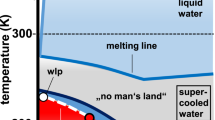Abstract
THE two-fluid model for liquid helium II first put forward by the late F. London1 has been largely accepted as at least a very useful working hypothesis. There are, however, certain thermodynamical difficulties arising from this model which do not seem to have received an entirely satisfactory solution. For example, Gorter2 has pointed out that an application of the phase rule leads to a unique triple point for the co-existence of the two fluids and the vapour phase, whereas, in fact, a whole range of such points is observed; and he has suggested that this may be explained by assuming that the Gibbs function for the fluids and vapour is not linear in the concentrations.
This is a preview of subscription content, access via your institution
Access options
Subscribe to this journal
Receive 51 print issues and online access
$199.00 per year
only $3.90 per issue
Buy this article
- Purchase on Springer Link
- Instant access to full article PDF
Prices may be subject to local taxes which are calculated during checkout
Similar content being viewed by others
References
London, F., Nature, 141, 643 (1938).
Gorter, C. J., Physica, 15, 523 (1949).
Smits, A., “Die Theorie der Allotropie” (Barth, 1921).
London, H., Proc. Roy. Soc., A, 171, 484 (1939).
Author information
Authors and Affiliations
Rights and permissions
About this article
Cite this article
HERIVEL, J. Thermodynamics of the Two-Fluid Model of Liquid Helium II. Nature 174, 322–323 (1954). https://doi.org/10.1038/174322a0
Issue Date:
DOI: https://doi.org/10.1038/174322a0
Comments
By submitting a comment you agree to abide by our Terms and Community Guidelines. If you find something abusive or that does not comply with our terms or guidelines please flag it as inappropriate.



